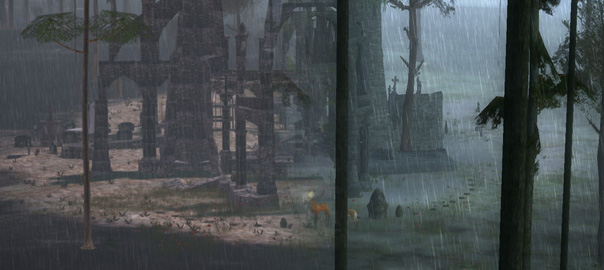The focus of this step has been changing the weather and the time of day in the forest.
To trigger these changes in the forest, the building of the interface for Abiogenesis has begun. Changing the time of day involves changing the color of the lights but also some materials. In the original game the color of almost all materials is changed but in Unreal only a few are needed to achieve the desired effect. Some other things change as well when the time of day changes: instead of butterflies, fireflies appear above flower beds and instead of doves, swarms of bats fly overhead. The sound changes too when night falls, both the general atmosphere and specific sounds of nature are different. All the sound files of the old game were reused.
Changing the colors for the time of day worked out okay with Unreal’s standard atmosphere system. But to approximate the subtlety (and complexity) of the original game when changing the weather, a new system needed to be built that allowed the reuse of specific colors and numbers in the old game. With the colors of sky and lights in place, it was relatively straightforward to implement the particles systems for rain, snow and mist, using the original textures (although the resolution of snow was increased). And to replicate how the sound is affected by weather changes.
When comparing screenshots of the old and new game, it became clear that our camera setup still didn’t match the original game. As it turns out, the field of view in The Endless Forest is exceptionally narrow. I think we chose to do this to reduce perspective distortion of the tree trunks. A more narrow view also means that the camera needs to be further away. This change required all sorts other tweaks to sound, particles systems, and so on.
Implementing time of day and weather took a lot more effort that anticipated. But I’m glad it’s done. And I love how it looks.
Thank you for your support!
— Michaël Samyn.
